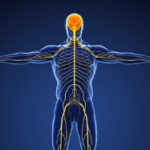
Hi All,
When you hear the word “neuroscience”, what do you think of first? – The brain? That’s fair. 🙂 However, (to be precise) neuroscience is the study of the nervous system (of which the brain is a part).
In this article, we will look at the individual parts and functions of the nervous system and cover different types of stress responses (the four F’s: fight, flight, freeze, fawn). In the following article, we will then discuss actionable ways to regulate our nervous system so we can move from stress to a calmer, more balanced state. Also, we will clarify what the Vagus nerve has to do with all of this.
Let’s start!
The Nervous System: Overview
The nervous system (NS) consists of the brain, the spinal cord, and a complex network of nerves that run through our body. From a medical standpoint, the nervous system is what makes us alive – it controls nearly everything, from our organs to everything we feel, think, and do.
Let’s have a look at its parts and functions: 
The Nervous System: Central vs. Peripheral
Starting from the top of the graph, the nervous system can be divided into two major subdivisions: The central nervous system (CNS) and the peripheral nervous system (PNS). (See in the cover image.)
The Central Nervous System (CNS):
The CNS is made up of the brain and the spinal cord. It is the best-protected part of the human body.
The Peripheral Nervous System (PNS):
The PNS consists of the nerves running through the body. They carry messages between the CNS and the muscles, organs, and senses (i.e., everything outside of the CNS).
As you may have seen on the graph above, in this article, we will mainly focus on the PNS, as we have already covered the CNS in more depth in previous articles (e.g., brain anatomy).
The Peripheral Nervous System: Somatic vs. Autonomic
The Somatic Nervous System:
The somatic nervous system (not abbreviated as SNS) is responsible for our conscious and voluntary movement.
Sensory neurons carry sensory information from the body to the CNS, and motor neurons carry motor information from the CNS to the body/muscles. For example, when you walk onto hot sand, your sensory neurons send the information ‘hot’ to the CNS/your brain. In response, your motor neurons send the information ‘move’ from the CNS to your muscles, and you step back into the shade. Easy, right?
Let’s look at processes that happen subconsciously:
The Autonomic Nervous System (ANS):
The autonomic nervous system is associated with the involuntary control of automatic processes. It carries signals between internal organs and the CNS, regulating the body’s internal environment. Involuntary physiological processes include heart rate, blood pressure, respiration, digestion, body temperature, and emotions.
The ANS is my second favourite part of the nervous system (after the brain), as I believe that there is much more to learn and uncover here. The majority of processes in our body and mind operate subconsciously and are significant aspects of our ‘programming’ or who we are. When we seek to change a part of ourselves (e.g., patterns of thought, perception, or behaviour), we have to go beyond the conscious and work with our subconscious (body and mind).
Before we delve into the parts of the ANS, let’s take a quick look at emotions: The ANS influences our emotional responses. Neuroscientist Candace Pert suggests that our body acts as our subconscious mind, communicating with us through emotions. Our subconscious beliefs often manifest in the emotions we feel in our bodies. One way to gain more insight into your subconscious is by becoming aware of your body’s responses to certain situations. For example, if you consciously believe that you are experienced enough to deserve a seat at the table, pay attention to the emotions that arise in your body when you take this seat. Are the emotions you are experiencing aligned with your conscious thoughts? If not, your subconscious might still hold beliefs that you are ‘not good enough.’ (We can change our subconscious beliefs, but that’s a topic for another day).
The Autonomic Nervous System: Sympathetic vs. Parasympathetic vs. Enteric
In short, the ANS is subdivided into three parts: 1) the Sympathetic Nervous System (“fight, flight, freeze”), 2) the Parasympathetic Nervous System (“rest and digest”), and 3) the Enteric Nervous system (“the second brain”).
We will start with the first two parts (sympathetic/parasympathetic) as they have complementary functions and operate in tandem, before moving to our “second brain”, the enteric system.
The Sympathetic Nervous System (SNS):
When we are faced with a threat or high-arousal situation, the sympathetic nervous system gets activated. It prepares the body for stress-related activity. For example, this causes the liver to release glucose, adrenaline to surge into the bloodstream, heart rate and blood pressure to increase, and pupils to dilate. These physiological changes allow us to access energy reserves and give us heightened sensory capacity.
Today, a lot of stressors are of a psychological nature (e.g., a work deadline) rather than a physical threat (e.g., a predatory attack). However, even if a psychological stressor does not put our life on the line, our bodies react as if it were (i.e., we experience the same physiological responses in our bodies).
We all know that prolonged periods of stress can damage our bodies: one reason being that if we are stuck in a high-arousal (/sympathetic) state, some parts of the body get “overworked” (e.g., the heart) and some parts of the body don’t receive enough energy to maintain healthy functioning (e.g., our digestive system). Overall, our bodies fall out of balance, which can impact practically every system in our body. As a reminder, stress is linked to nearly every disease, ranging from e.g., heart and metabolic diseases to diabetes, depression and anxiety.

We will look into different types of stress responses (the four F’s: Fight, Flight, Freeze, Fawn) in a separate section below but first, let’s see which part of the nervous system helps us come back into balance.
The Parasympathetic Nervous System (PSNS):
The parasympathetic nervous system (PSNS) returns the body to routine, day-to-day operations. It is also called the rest-and-digest (or rest-and-repair) system and puts our body back into a calm state. For example, the PSNS slows the body’s heart rate and increases the activity of intestines and glands during periods of rest. As mentioned above, the ability to return our bodies to a balanced state is essential for our health and we will cover actionable methods (and the role of the Vagus nerve) in next month’s article to ensure we give this topic enough space and attention.
Overview of the physiological responses of the parasympathetic vs. sympathetic NS:

The Enteric Nervous System (ENS):
Last but absolutely not least: The enteric nervous system is suggested to be the largest and most complex unit of the peripheral nervous system. It is an extensive neuronal network located inside the gastrointestinal (GI) tract and plays a crucial role in the gut-brain connection. It can function independently of the brain but it is in constant connection with it through the Vagus nerve and other neuronal pathways, forming the gut-brain axis. Researchers argue that there are more neurons in the human gut than in the entire spinal cord.
The ENS is involved in a wide range of processes including immunological defence, neurotransmitter and hormone production and regulation, blood flow regulation to intestines, and nutrient handling. Sensory neurons in the GI tract “scan” the internal environment and act accordingly by adjusting any of the above-mentioned processes. It also alerts the brain if something is wrong (your gut feeling!).
Similar to the other parts of the nervous system, the ENS is sensitive to (chronic) stress which can lead to GI disorders such as IBS (irritable bowel syndrome) and IBD (inflammatory bowel disease).

If you ever wondered what a preserved nervous system looks like, here is a photo from Body Worlds. Isn’t it fascinating that this controls just about everything in our life?

Before we get into the different types of stress responses: If you would like to support my work, here’s a way: Ko-fi.com/neurosciencemusings. If you choose to do so: Thank you!!
Now,
Stress Responses: The Four F’s
If we are confronted with a threat, our bodies get stressed. However, the type of response and resulting behaviour can vary from person to person and can also be situation-dependent. The following responses to threats are observed in both humans and animals:
1. Fight
- The body is ready to attack in order to protect oneself. Aggression levels are high.
⇒ Safety is achieved by defending oneself.
2. Flight
- As the term implies, the body is trying to escape and flee in order to avoid danger.
⇒ Safety is achieved by removing oneself.
3. Freeze
- The body moves into a state of paralysis, often caused by shock or a threat perceived as not escapable or winnable. The nervous system is overwhelmed to the point of dissociation. If a person is in “freeze,” their body disconnects in an attempt to numb reality.
⇒ Safety is achieved by “shutting down.” - Sidenote: So far, the neurobiological mechanisms of the freeze response are much less known compared to the fight and flight responses.
4. Fawn
- This response is associated with social situations and involves appeasing or pleasing the aggressor to avoid harm. Individuals who exhibit the fawn response may engage in behaviours such as people-pleasing, compliance, and self-sacrifice to avoid conflict or ensure their safety in threatening situations.
⇒ Safety is achieved by submission. - Sidenote: In comparison to the other responses, the fawn response is more of a learned behaviour (mainly in childhood) rather than a physiological response triggered by the body.
The topics of stress and trauma are complex and far-reaching. This overview is a simplified first look, and we can dig deeper into it in coming publications.
For questions, reach me on Instagram @neuroscience.musings or via the contact form.
Have a great day/night wherever you are!!
Best regards,
Sarah
Resources:
- Waxenbaum, J. A., Reddy, V., & Varacallo, M. (2019). Anatomy, autonomic nervous system.
- Chandola, T., Brunner, E., & Marmot, M. (2006). Chronic stress at work and the metabolic syndrome: prospective study. Bmj, 332(7540), 521-525.
- Glaser, R., & Kiecolt-Glaser, J. K. (2005). Stress-induced immune dysfunction: implications for health. Nature reviews immunology, 5(3), 243-251.
- Purves, D., Augustine, G., Fitzpatrick, D., Katz, L., LaMantia, A., McNamara, J., & Williams, S. (2001). Neuroscience 2nd edition. sunderland (ma) sinauer associates. Types of Eye Movements and Their Functions.
- Fleming, M. A., Ehsan, L., Moore, S. R., & Levin, D. E. (2020). The enteric nervous system and its emerging role as a therapeutic target. Gastroenterology research and practice, 2020.
- Roelofs, K. (2017). Freeze for action: neurobiological mechanisms in animal and human freezing. Philosophical Transactions of the Royal Society B: Biological Sciences, 372(1718), 20160206.
- Xu JQ, Murphy SL, Kochanek KD, Arias E. Mortality in the United States, 2021. NCHS Data Brief, no 456. Hyattsville, MD: National Center for Health Statistics. 2022. DOI: https://dx.doi.org/10.15620/cdc:122516.
- Roelofs, K. (2017). Freeze for action: neurobiological mechanisms in animal and human freezing. Philosophical Transactions of the Royal Society B: Biological Sciences, 372(1718), 20160206.
- https://neuroscientificallychallenged.com/posts/2-minute-neuroscience-divisions-of-the-nervous-system
- https://opentextbc.ca/h5ppsychology/chapter/parts-of-the-nervous-system/
- https://www.healthdirect.gov.au/nervous-system#:~:text=It%20controls%20many%20aspects%20of,information%20gathered%20through%20the%20senses
- https://www.ncbi.nlm.nih.gov/books/NBK539845/#:~:text=The%20autonomic%20nervous%20system%20is,sympathetic%2C%20parasympathetic%2C%20and%20enteric.
- https://www.massagetoday.com/articles/13725/Emotions-and-Your-Nervous-System#:~:text=Different%20types%20of%20emotions%20send,like%20cascading%20waves%20of%20energy.
- https://www.mhs-dbt.com/blog/parasympathetic-nervous-system-and-trauma/#:~:text=Traumatic%20events%20push%20the%20nervous,ready%2Dto%2Dreact%20mode.
- https://www.cancer.gov/publications/dictionaries/cancer-terms/def/visceral#:~:text=Having%20to%20do%20with%20the,%2C%20reproductive%2C%20and%20circulatory%20systems.
- https://bodyworlds.com/exhibitions/human/
- https://www.pbs.org/video/stan-hywet-hall-gardens-hour-1-guhxyq/?continuousplayautoplay=true


